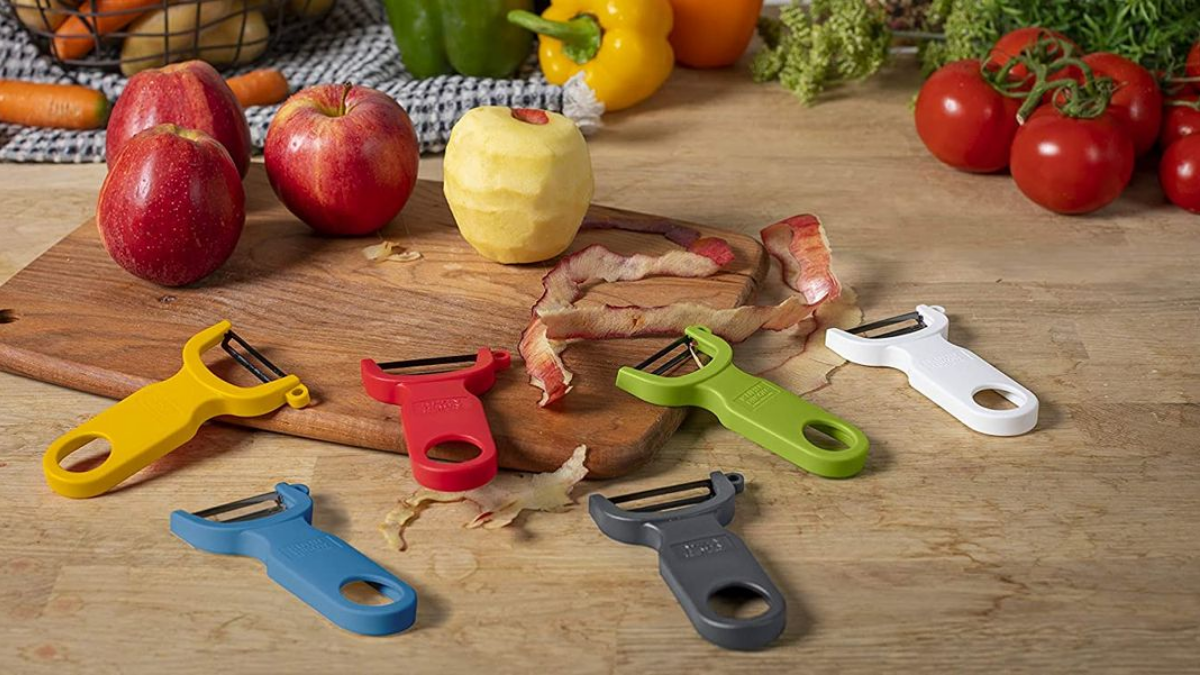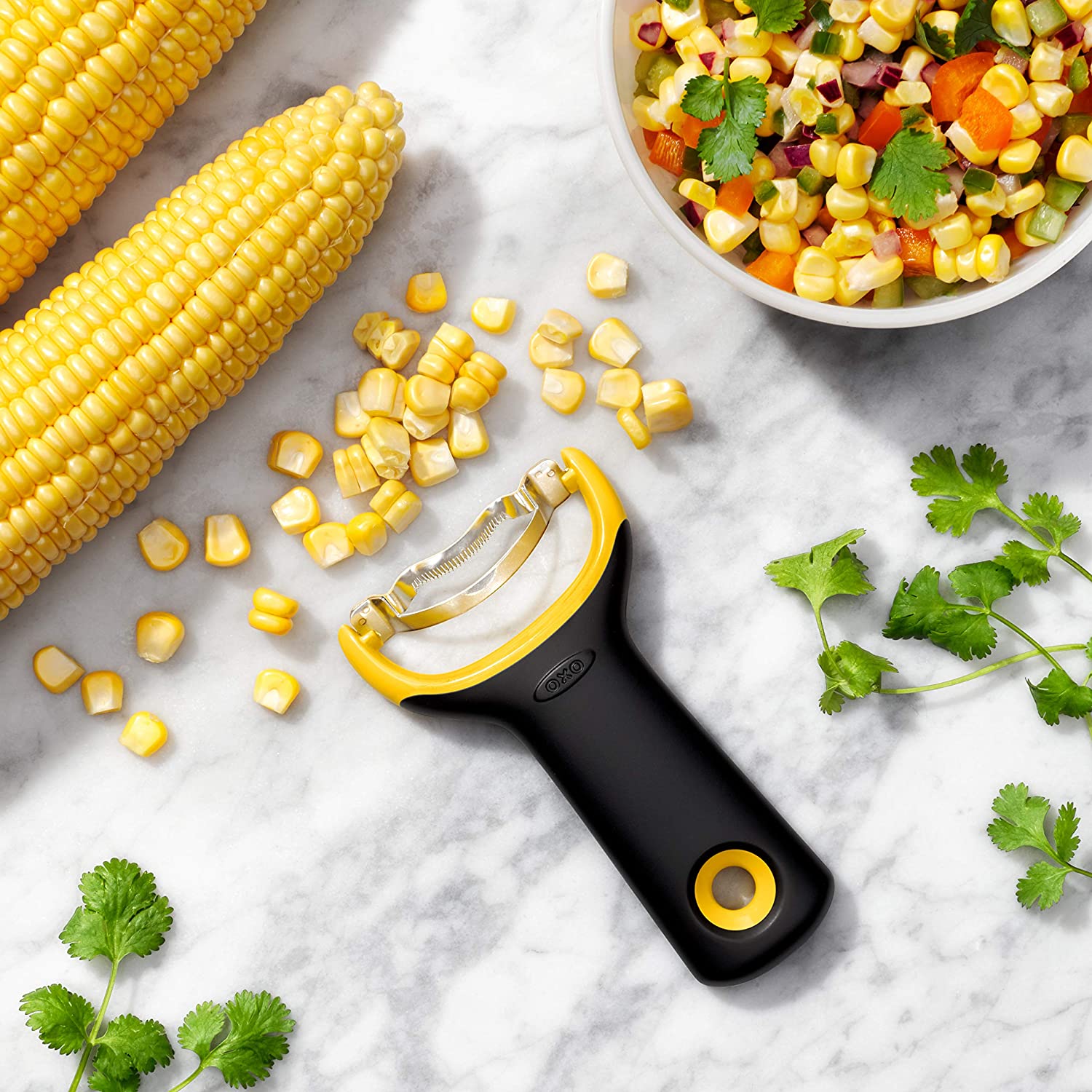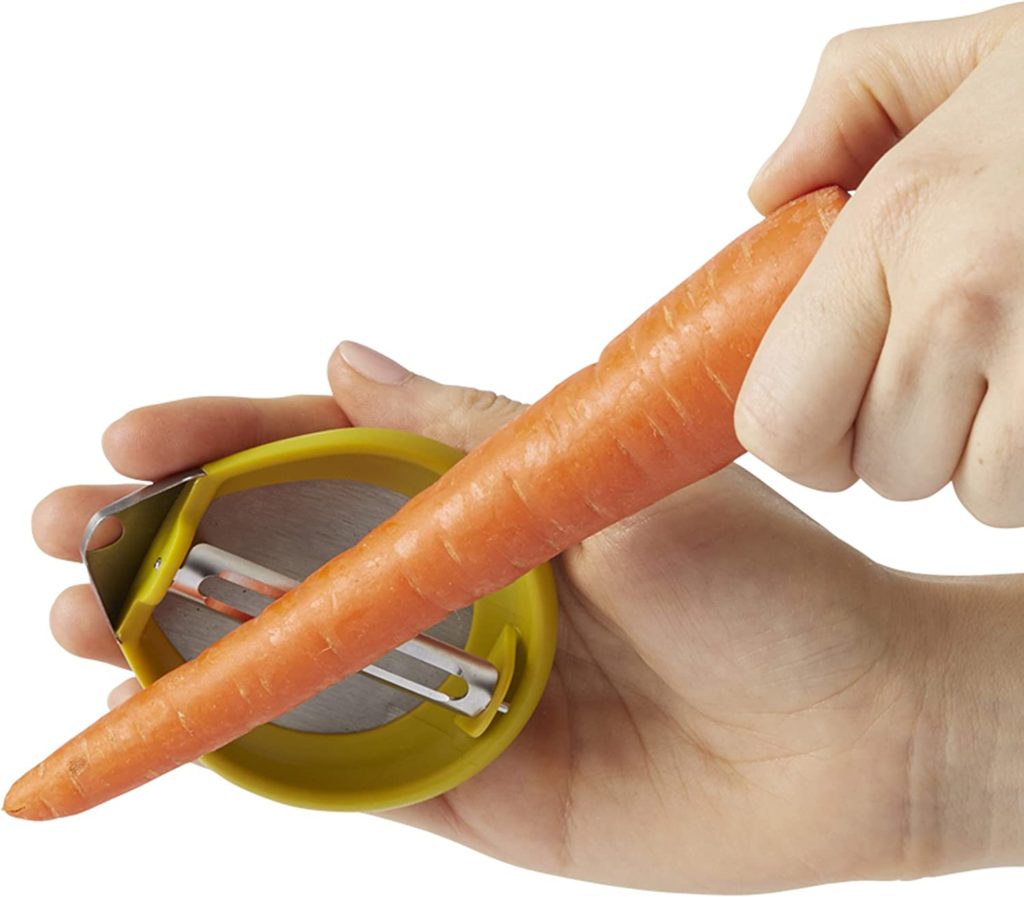Even though peeling vegetables is a vital kitchen duty, many home cooks concur that it is not the most fun. Fruits and vegetables can be peeled without much effort or talent, but you will need a sturdy, sharp tool that will last you a long time and work well on various food. A poor peeler makes things difficult for us and ends up unnecessarily hurting our wrists and arms.
Although a vegetable peeler and a potato peeler are quite similar, a vegetable peeler might differ in size and blade type to better suit different cuisines. For instance, tomatoes are much simpler to peel with a serrated blade due to their thin skin and sensitive flesh. A broader blade is advantageous for large vegetables with tougher skins, such as eggplant and butternut squash. On the other hand, asparagus can be peeled more effectively using a smaller, more curved blade. Once you have a useful tool in your possession, your peeler can be put to all kinds of inventive new purposes.
What is Exactly Vegetables Peeler?
Using a metal blade with a slot and a sharp edge linked to a handle, a peeler (also known as a vegetable scraper) is a kitchen instrument that is used to remove the outer layer (also known as the “skin” or “peel”) of several vegetables and fruits, such as potatoes, broccoli stems, and carrots.
Vegetable peeling can also be done with a paring knife. A slot in the blade of a peeler has one sharpened side that keeps the blade from cutting too deeply into the vegetable. Peelers come in a variety of modern designs. Most portable peelers are either straight or Y-type, though specific designs differ by location and preference.
Types of Peelers
Here are the types of peelers:
Y-Peeler
Y-peelers, also known as universal peelers, are named for their shape and have gotten more popular in the last few years. They’re designed so that both right-handed and left-handed cooks can work with them. To use Y-peelers, you must pull the swivel blade down the fruit or vegetable rather than push or pull across the produce.
Euro Peeler
Euro peelers are a bit more traditional and closer to what Grandma used in her kitchen than the Y-peeler. They have a blade attached to the handle, but there’s also an arch that extends behind the blade. That gives the blade enough movement to adjust to the product’s outer layer and move along with the surface instead of making your hand do all the work.
Standard Peeler
If you don’t like the instability of a swivel blade, you also have the option of the non-swivel blade with the standard peeler. It controls the person doing the work rather than using the fruit or vegetable as a guide. It works just as well as the other peelers—it just depends on how much blade movement you’re comfortable with.
Best Vegetable Peelers for Kitchen
Here are some of the best vegetable peelers that can be used in your kitchen:
Swissmar Peeler Scalpel Blade, Blue
Features:
Features:
- A vertical blade peels smooth-skinned fruits and vegetables quickly and easily
- Serrated, stainless-steel blade bites into smooth and fuzzy skins and peels them off in smooth, thin strips
- The plastic handle is ergonomically designed for easy grip
- Dishwasher safe; Available in a choice of colors
- Hole in handle for easy hanging storage
KitchenAid Spiralizer Plus Attachment with Peel
Features:
- Attaches to the Power Hub Of your stand mixer and uses the power of the motor to run the attachment
- Fits all Household KitchenAid Stand Mixers
- With six quick-change blades and an optional peeling blade to inspire healthy versions of classic recipes and unleash your culinary potential
- 3 Spiraling Blades – Medium, Fine, and Extra Fine; 3 Slicing Blades – Slicing (Large Core), Slicing (Small Core), and Thin Slice (Small Core); Peeling Blade
- All Blades are dishwasher safe on the top rack. The body can be wiped clean with a warm damp cloth
OXO Good Grips Corn Prep Peeler
Features:
- Quickly and safely remove corn kernels from cobs with the OXO Good Grips Corn Prep Peeler
- Compact, comfortable, Y-peeler shape is easy to maneuver and works with every grip
- Sharp, durable, Japanese stainless steel blades won’t rust
- Non-slip ergonomic handle
- Dishwasher safe
Chef’n PalmPeeler Vegetable Peeler
Features:
- This ergonomic design fits comfortably in hand to effortlessly peel vegetables in seconds.
- Included blade guard keeps fingers safe and stainless steel swivel-blade sharper, longer.
- TIME SAVER: Features a built-in stainless steel potato eye remover to quickly remove sprouts without changing your grip
- The slim shape is perfect for drawer storage
- Top-rack dishwasher safe
What to Look for in a Vegetable Peeler?
Here are some important factors to consider while buying a vegetable peeler:
Blade Material
The blade of the peeler is its most crucial component. You may struggle to cut through some veggies if the blade is robust and sharp, and you also want a blade that stays sharp.
Blades can be made out of three different materials: carbon steel, ceramic, and stainless steel. Because stainless steel is the only substance that can be sharpened like knives, stainless steel blades are the most common. Although ceramic blades can be more prone to breaking or dulling than stainless steel ones, they are comparable to stainless steel in sharpness. Last but not least, if carbon steel blades are not properly maintained, they might rust. As a result, you will need to wipe down the blade after each usage to prevent it from getting wet.
Blade Design
In addition to the blade’s composition, the blade’s design should be considered. Some blades are finely edged, while others feature serrations. Think about which makes the most sense given the food you’ll be peeling.
If you want the flexibility to swap between serrated and straight blades, some peelers provide many blade options in one. Additionally, a swivel blade gives you more freedom to peel in both directions. In contrast, a stiffer, stationary blade requires you to hold it at the correct angle to catch the peel.
Think about how the blade peels both thoroughly and effortlessly. Each peeler has a different gap between the two blades. Because less of the second “guiding” blade will touch the food when it has a raised ridge, the first blade will peel the food more smoothly. Additionally, some blades are wider than others, which may be helpful if you frequently handle larger produce.
Power Source
Remember that you can choose between a manual and an automated vegetable peeler. It can be advantageous to get a free-standing electric peeler or a peeler attachment that works with your stand mixer if you want to reduce the amount of labor your hands have to perform. Stick with a manual peeler for more precision or faster results if you prefer to complete tasks by hand.
Handle
Straight handle or Y-peeler manual peelers are both available. You hold the blade on its side and operate sideways with the straight handles since the blade is parallel to the handle. This will resemble brushing your hair. Since the Y-blade peelers are parallel to the handle, you’ll work more vertically, as if you were painting a wall from top to bottom. Personal preference can greatly determine how different a stroke is.
How do you Sharpen a Vegetable Peeler?
Vegetables are rarely sharpened. Although it might be conceivable, it’s challenging to suitably sharpen both blades simultaneously because of how awkwardly the two parallel blades are shaped. To sharpen each blade separately, you might insert a metal nail file between the two, but doing so can be challenging.
The best strategy for maintaining your peeler ready to use and sharp is to look for models that allow you to swap out the blade. By doing this, you can keep the peeler’s body and avoid purchasing a brand-new peeler each time the blade becomes dull.
Your best chance for cleaning the peeler is to hand wash it in warm, soapy water, just like you would any other dirty instrument. Please avoid using the dishwasher since it will dull the blade. Use a soft scrub brush to gently dislodge any food particles attached to the blade before washing them away.
How it is Tested?
To find the best vegetable peelers, we sent them to our knowledgeable home chefs and product testers. They put them to the test on a variety of potatoes as well as other fruits and vegetables like apples, carrots, and zucchini. Each peeler was evaluated based on its design, adaptability, performance, usability, cleaning ease, and overall value. Then, our testers provided more information on the advantages and disadvantages of each peeler.
The idea behind this peeler is good; it offers various peeling alternatives without the inconvenience of buying other peelers, including straight and julienne blades. Whether right- or left-handed, switching cuts requires turning the handle around because each blade is on the opposite side. A tiny, sharp eye on the side of the peeler can be used to remove scars and blemishes. Sadly, our tester discovered that it was heavy and tiresome to operate and that the opposing blades were wide, making them difficult to use on little potatoes and fruits.
They did, however, do admirably on substantial carrots and enormous potatoes. When in operation, the two-in-one blade configuration tends to tingle and make a lot of noise. The supplied cleaning brush is useful for maintaining this equipment in peak condition because skin fragments frequently get stuck in the blades.
Conclusion
Did you know that a vegetable peeler can also be used to peel various fruits, cheeses, and even soaps? You may have used one to peel potatoes or carrots, and your cheapest kitchen appliance increased in value. A vegetable peeler has applications outside of the kitchen! Although we refer to them as vegetable or potato peelers, these implements are sharpened blades that are simple to grip and use. As a result, you could potentially carve many different objects with them or even sharpen pencils.
For beveling soap bars’ edges, so they have smooth, presentable edges, artisan soap makers frequently use vegetable peelers. The artistic soaps look more polished and enticing as a result.







